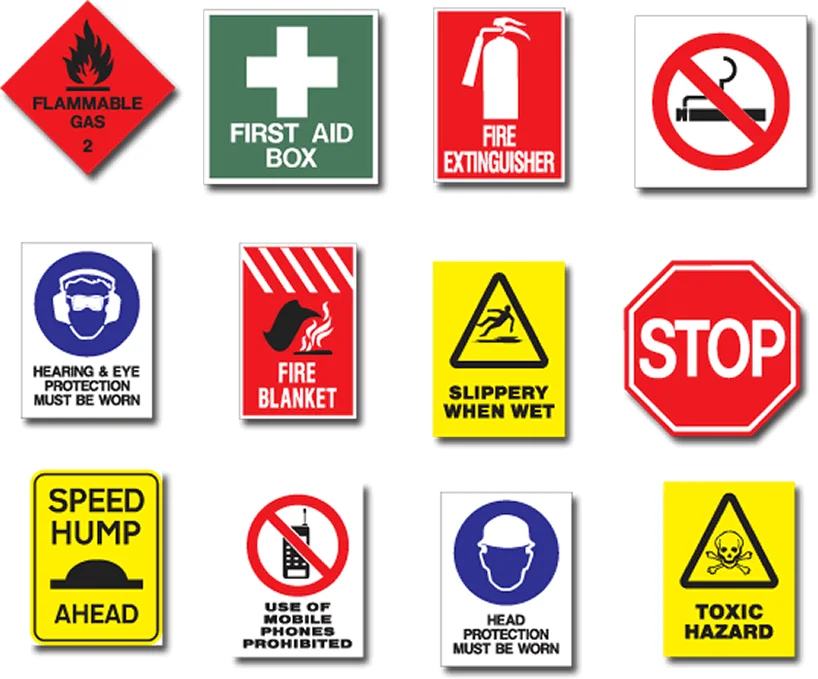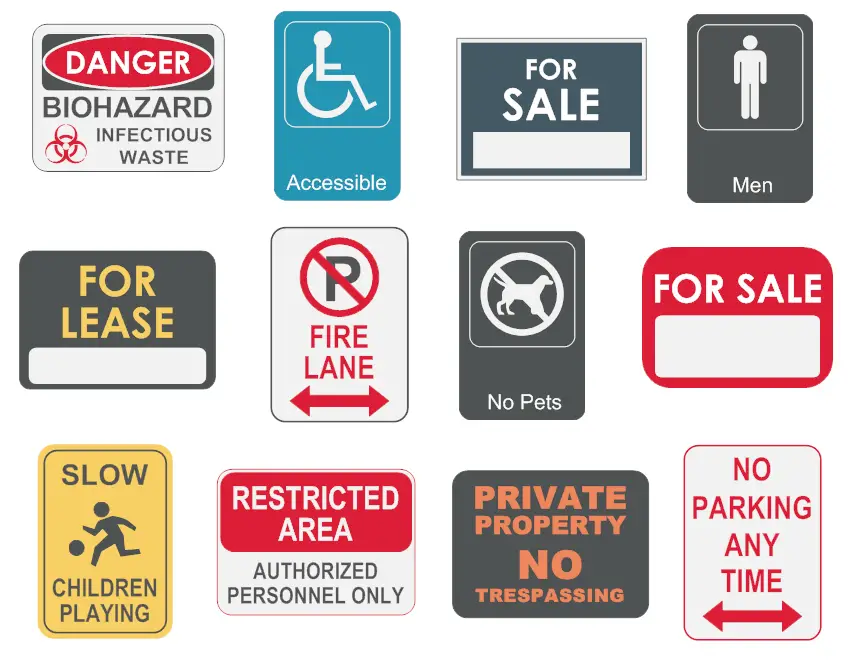Mastering the art of making signage involves considering a wide range of factors, from environmental impact to design and installation. By following best practices and complying with legal requirements, we can create effective and sustainable signage that effectively communicates our message while also being visually appealing and environmentally responsible.
Signs are visual communication tools that convey important messages to people. They can be found in various settings, such as on streets, in buildings, at public events, and on products. Signs serve a vital function in society, as they provide information, warn people of danger, and help guide individuals to their desired destination.
There are several types of signs, including informative signs, directional signs, regulatory signs, warning signs, and advertising signs. Informative signs provide information about a particular location or event, such as the name of a building or the schedule of a concert. Directional signs help people navigate their way to a specific location, such as a restroom or a particular store in a mall.
Regulatory signs inform people about rules and regulations, such as speed limits on roads or prohibitions on smoking in certain areas. Warning signs alert people to potential dangers, such as construction zones or hazardous materials. Advertising signs are used to promote products or services.
Signs can be made from a variety of materials, including metal, plastic, wood, and paper. They can also be illuminated or non-illuminated, depending on the location and purpose of the sign. Illuminated signs are commonly used in public areas or on storefronts to attract attention and promote visibility.
Signs are an important part of our daily lives and help us to navigate the world around us. They provide information, guidance, and warnings that help keep us safe and informed. As such, it is important for signs to be clear, concise, and easily understandable so that everyone can benefit from their messages.
Mastering the Art of Making Signage

Signage is an essential aspect of communication that helps individuals and organizations convey information to their intended audience. From directional signs to promotional banners, mastering the art of making signage is a skill that can greatly benefit anyone who needs to communicate visually.
When creating signage, it’s important to keep in mind various factors such as the audience, location, and purpose of the sign. But before diving into the design process, it’s crucial to consider the impact that signage can have on the environment. Air pollution caused by manufacturing processes used in signage production can contribute to global warming and have adverse effects on public health.
Therefore, it’s vital to choose eco-friendly materials and sustainable manufacturing methods. One useful technique in the signage creation process is the SCAMPER method. This method involves brainstorming different ways to modify an existing sign or create a new one by asking questions such as, “What can we substitute?”, “What can we combine?”, and “What can we eliminate?”.
Using this method can help generate innovative ideas and improve the overall effectiveness of the sign. Another factor to consider when creating signage is trip waste. This refers to the waste generated from trips made to the sign manufacturer, design team, and installation site. To reduce trip waste, it’s important to work with a local manufacturer and design team and plan the installation process in advance.
Read Also: The Model of the Earth Project
When disposing of old signage, it’s important to keep in mind that U listed waste are always materials such as fluorescent bulbs and batteries, can have harmful effects on the environment if not disposed of properly. Therefore, it’s crucial to dispose of old signage in an environmentally responsible way.
Mastering the art of making signage involves considering various factors, including the impact on the environment, using effective techniques such as the SCAMPER method, and minimizing waste in the production and disposal processes. By doing so, we can create effective and sustainable signage that effectively communicates our message while also minimizing harm to the environment.
Effective signage not only conveys the intended message but also captures the attention of the intended audience. One way to achieve this is by using eye-catching designs and colors that are easy to read from a distance. It’s important to choose the right font size, typeface, and color contrast to ensure maximum visibility and readability.
The location of the sign plays a crucial role in its effectiveness. Signs placed in high-traffic areas, such as busy roads or shopping centers, should be designed to grab the attention of passersby and communicate the intended message quickly and clearly. The size and placement of the sign should also be carefully considered to ensure it’s visible from different angles and distances.
When designing signage, it’s important to consider the intended audience and their needs. For example, signs designed for children should use bright colors and playful designs that appeal to their sense of curiosity and wonder. In contrast, signs designed for professionals or businesses should use more formal designs and fonts that convey a sense of authority and professionalism.
It’s important to consider the longevity of the sign. Signs that are designed to last longer require durable materials that can withstand the elements and resist fading or damage over time. Choosing the right materials, such as aluminum or acrylic, can ensure that the sign remains effective and visible for years to come.
Mastering the art of making signage involves considering a variety of factors, including the impact on the environment, effective techniques for design, minimizing waste, and understanding the intended audience. By following these guidelines, we can create signage that effectively communicates our message while also being sustainable and environmentally responsible.
Read Also: The Devastating Water Pollution Consequences
In addition to the factors mentioned above, it’s important to consider the legal requirements when creating signage. Different areas may have specific laws and regulations regarding the placement, size, and content of signage. Therefore, it’s important to research and comply with these regulations to avoid legal issues and fines.
Another important aspect of signage is its ability to be easily understood. The message conveyed by the sign should be clear and concise, using simple language and avoiding jargon. The use of symbols and images can also help convey the intended message quickly and effectively.
The branding of a business or organization can be incorporated into the design of the sign, ensuring consistency and recognition across all marketing materials. Consistent branding can help build brand recognition and improve the overall image of the business or organization.
The installation process should be carefully planned and executed. Signs that are not installed properly can be unsafe and ineffective. It’s important to follow safety protocols and ensure that the sign is securely installed in the intended location.
One important consideration when creating signage is the intended purpose of the sign. Different types of signage are used for different purposes, such as directional signage, promotional signage, or informational signage. Understanding the purpose of the sign can help guide the design process and ensure that the sign effectively communicates its intended message.
Moreover, in today’s digital age, signage can also be used to drive online engagement and social media interactions. By incorporating QR codes or hashtags into the design of the sign, businesses and organizations can encourage viewers to engage with them online and share their experiences on social media.
It’s also important to consider the maintenance and upkeep of the sign. Over time, signs can become worn or damaged, which can affect their effectiveness and visibility. Regular maintenance, such as cleaning or repainting, can help ensure that the sign remains in good condition and continues to convey the intended message effectively.
Signage can also be used as a tool for environmental education and awareness. By using eco-friendly materials and sustainable manufacturing methods, businesses and organizations can showcase their commitment to environmental responsibility and raise awareness about the importance of sustainability.
Mastering the art of making signage involves considering a wide range of factors, from the intended purpose of the sign to its environmental impact and maintenance requirements. By following best practices and incorporating innovative design elements, we can create effective and sustainable signage that effectively communicates our message while also being visually appealing and environmentally responsible.
Another important consideration when creating signage is its accessibility. Signs should be designed to be easily readable and understandable for people with disabilities, including those with visual or cognitive impairments. This can be achieved by using high-contrast colors, large fonts, and clear and concise language.
In addition to accessibility, the language and tone used in signage can also have a significant impact on its effectiveness. Signs that use positive and empowering language are more likely to resonate with viewers and inspire them to take action. Conversely, signs that use negative language or fear-based messaging may be less effective and even discourage people from taking action.
When creating signage, it’s important to consider the cultural context in which it will be displayed. Signs that are intended for a global audience should be designed to be culturally sensitive and avoid potentially offensive or inappropriate language or imagery.
The design of the sign can also be used to reflect the values and mission of the business or organization. By incorporating elements of the brand’s identity, such as logos or slogans, into the design of the sign, businesses can strengthen their brand identity and create a consistent visual identity across all marketing materials.
Mastering the art of making signage involves considering a wide range of factors, from accessibility and cultural sensitivity to language and branding. By following best practices and incorporating innovative design elements, we can create effective and sustainable signage that effectively communicates our message while also being visually appealing, culturally sensitive, and environmentally responsible.
One additional factor to consider when creating signage is the location and environment in which it will be displayed. For example, outdoor signage may need to withstand harsh weather conditions, while indoor signage may need to fit into a specific design aesthetic.
Outdoor signage may also be subject to local regulations and requirements, such as restrictions on the size or placement of the sign. It’s important to research these regulations before designing the sign to ensure that it complies with all applicable laws and guidelines.
The materials used to create the sign can also impact its effectiveness and longevity. Outdoor signage may need to be made from durable materials that can withstand exposure to sunlight, rain, and wind, while indoor signage may have more flexibility in terms of materials used.
The lighting used to illuminate the sign can also have a significant impact on its visibility and effectiveness. LED lighting, for example, is a popular and energy-efficient option for illuminating signs, and can help make the sign more visible in low-light conditions.
When creating signage, it’s important to consider the intended audience and how they will interact with the sign. For example, if the sign is intended to be viewed from a distance, it may need to be larger and have more prominent text and images.
Mastering the art of making signage involves considering a wide range of factors, from location and environment to materials and lighting. By following best practices and incorporating innovative design elements, we can create effective and sustainable signage that effectively communicates our message while also being visually appealing, durable, and environmentally responsible.
Read Also: AHCCCS Online: Arizona’s Medicaid Program Goes Digital for Improved Access to Healthcare

